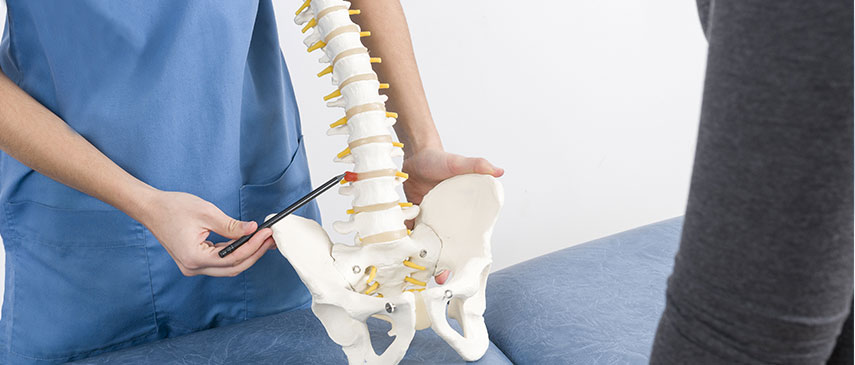5 ways PT can help reduce your herniated disc recovery time

The spine consists of 33 vertebrae stacked on top of each other. Intervertebral discs separate them. These discs are a cartilage cushion between the bones and provide a cushion for the spine. A herniated disc occurs when the cartilage is torn, causing the gel-like core of the disk to leak. It can happen as a result of trauma or prolonged pressure on the spine. It typically affects people between the ages of 30 to 50. Men are twice as likely to be diagnosed than women. This condition can have an increased risk of happening due to repeated lifting, participating in weight-bearing sports, obesity, smoking and poor posture. Fortunately, the majority of herniated discs respond well to treatments, including physical therapy.
How does a herniated disc feel?
A herniated disc can cause you to experience pain, tightness, numbness, weakness or tingling in the neck, back, arms or legs. When the bulging disc puts pressure on a nearby nerve, it can result in pain or muscle weakness. However, you can have a herniated disc and not experience pain caused by a compressed nerve. Back or neck pain attributed to a herniated disc may also have other contributing factors. Your physical therapist can help determine any underlying issues that can be contributing to your pain.
How is a herniated disc diagnosed?
A herniated disc can be diagnosed through a thorough evaluation by a health care professional like a physical therapist. During your examination, your physical therapist may ask about your injury, such as:
- How and when did the pain start?
- Is there a time of day that the pain is worse?
- What pain and discomfort do you feel, and where is it located?
- Is there anything in your life that is being affected by the pain?
In addition to asking questions, your physical therapist may perform tests to find any specific physical problems like:
- Difficulty moving, including when walking.
- Tightness or weakness in your muscles.
- Numbness.
- Loss of reflexes.
- Stiffness.
- Poor posture.
How can physical therapy help a herniated disc?
In almost every instance of a herniated disc, conservative care, including physical therapy, can help. In extreme cases, surgery or pain medication may be necessary. Your physical therapist can design a personalized treatment program to help your recovery. The duration of healing can vary; it is possible to see results as quickly as two to eight weeks. Initially, your physical therapy may recommend:
- Resting the area by avoiding doing activities that cause your symptoms to worsen.
- Avoiding bed rest.
- Staying active by taking several short walks a day.
- Applying ice packs to the affected area every two hours.
- Sitting in firm chairs, which avoids making problems worse.
Once your physical therapist designs a personalized treatment program, you may have these techniques included in your plan:
- Manual therapy — Your physical therapist may use techniques like joint mobilization and soft tissue mobilization to help improve joint mobility and alleviate muscle tension. These techniques can help improve your spinal function, relieve pain and support your body’s natural healing process.
- Therapeutic exercises — Your physical therapist can recommend a customized exercise program to help target muscle strengthening, core stabilization and flexibility. These exercises can help strengthen your supporting muscles, reduce strain on the affected disc and promote a faster recovery.
- Graston Technique® — The Graston Technique is a manual therapy technique certified physical therapists use. Your physical therapist will use specially designed stainless steel instruments to address scar tissue and fascial restrictions. This instrument-assisted soft tissue mobilization technique can help promote faster healing by breaking down adhesions and enhancing tissue mobility.
- Trigger point release — Trigger point release is used by a physical therapist to put manual pressure on trigger points to help alleviate muscle knots and pain. It can help relieve muscle tension, reduce pain, and support your recovery.
- Electrical stimulation — Electrical stimulation uses electrodes strategically placed near an affected area to allow low-level electrical currents to help stimulate nerves and reduce pain. This modality can help control pain, improve muscle function, and improve the effectiveness of other therapeutic interventions.
Physical therapy can help you:
- Reduce pain and symptoms.
- Improve posture.
- Restore motion.
- Boost flexibility.
- Build strength.
- Boost endurance.
In addition, physical therapy can help ensure you have a more efficient and sustainable recovery time. Under the guidance of your physical therapist, you can unlock the potential for a healthier and less painful life after a herniated disc.
Experience personalized herniated disc recovery with Franklin Rehabilitation
At Franklin Rehabilitation, we understand the uniqueness of your journey with herniated disc pain. Our expert physical therapy team can be your dedicated partner to steer you toward a less pain-filled and more active life. We believe in equipping you with the knowledge and tools to help you overcome the challenges of a herniated disc. You can trust us to help guide you through a seamless rehabilitation.
Call us or request an appointment today for help with your herniated disc recovery.
